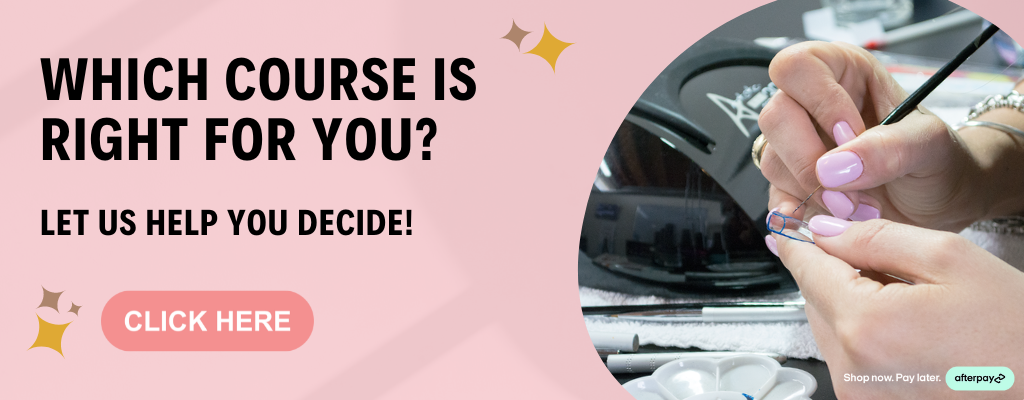-
Introduction
You can skip this section if you do not plan on completing the full Foundation Certificate in Nail Technology
-
1 Admin
-
2 Client Consultations
- VIDEO LESSON – Client Consultations
- 2.1 Consultations = Customer Service
- 2.2 When the Client Arrives
- 2.3 Making Recommendations
- 2.4 Other Information to Gather
- 2.5 After the Appointment
- 2.6 Summing It Up
- 2.7 Sample Client Card
- 2.8 Consultations Activity (Optional)
- 2.9 Client Consultations Quiz (Optional)
- 2.10 We Don’t Believe in Homework But… (Part 1)
-
3 Sanitisation and Safety
- VIDEO LESSON – Sanitisation and Safety
- 3.1 Introduction to Basic Salon Sanitisation
- 3.2 When a Client Arrives (Wall Print Out)
- 3.3 Sanitisation and Disinfection of Tools and Implements
- 3.4 Correct Methods of Disinfection
- 3.5 When a Client Leaves (Wall Print Out)
- 3.6 Individual Client Packs
- 3.7 Added Responsibilities for Pedicure Equipment
- 3.8 Added Responsibilities for Blood and Bodily Fluids
- 3.9 Blood Spill (Wall Print Out)
- 3.10 Safe Use of Reusable Products
- 3.11 The Importance of Ventilation
- 3.12 First Aid
- 3.13 Ergonomics
- 3.14 Ergonomics Activity
- 3.15 Educating Clients
- 3.16 Self Evaluation 1 (Print Out)
- 3.17 Self Evaluation 2 (Print Out)
- 3.18 We Don’t Believe in Homework But… (Part 2)
-
4 Nail Anatomy and Disorders
- VIDEO LESSON Nail Anatomy
- 4.1 Introduction
- 4.2 Basic Nail Anatomy
- 4.3 Self Evaluation
- 4.4 Nail Anatomy Quiz (Optional)
- VIDEO LESSON – Disorders
- 4.5 Nail Disorders
- 4.6 Nail Pitting
- 4.7 Terry’s Nails
- 4.8 Beau’s Lines
- 4.9 Onycholysis
- 4.10 Yellow Nail Syndrome
- 4.11 Nail Clubbing
- 4.12 Koilonychia (Spoon Nails)
- 4.13 Paronychia
- 4.14 Onychomycosis (Nail Fungus)
- 4.15 Pseudomonas (Greenies)
- 4.16 Dermatophytes
- 4.17 Melanonychia
- 4.18 Nail Disorders Activity
- 4.19 Nail Disorders Quiz (Optional)
- 4.20 Nail Troubleshooting
- 4.21 Nail Troubleshooting Activity (Printable)
- 4.23 We Don’t Believe in Homework But… (Part 3)
-
Biohazards
- VIDEO LESSON Biohazards
- 5.1 What is a Biohazard?
- 5.2 The Risks
- 5.3 Steps to Prevent Exposure
- 5.4 What Should I Do If I Am Exposed To Bodily Fluids?
- 5.5 Biohazards Research Activity – PDF
- 5.6 Biohazards Quiz (Optional)
- 5.7 Blood Spill Drill
- 5.8 Blood Spill Drill Answers
- 5.9 We Don’t Believe in Homework But… (Part 4)
-
Chemical Hazards
- VIDEO LESSON – Chemical Hazards
- 6.1 Chemical Hazards
- 6.2 How To Reduce Exposure Due To Inhalation
- 6.3 How To Reduce Skin Exposure
- 6.4 Reduce The Risk Of Accidental Swallowing
- 6.5 The Risks of Exposure to Chemicals Via the Nail Plate
- 6.6 Checklist for Salons
- 6.7 Checklist for Employees
- VIDEO LESSON – Ingredients
- 6.8 Potential Symptoms and Health Effects of Overexposure
- 6.9 Methyl Methacrylate (MMA)
- 6.10 Vegan Products
- 6.11 Dragon’s Den UK Highlight the Difference Marketing Makes
- 6.13 MSDS Sheets
- 6.14 Artistic Nail Design and Be Creative MSDS Sheets
- 6.15 MSDS Activity
- 6.16 Chemical Hazards Quiz (Optional)
- 6.17 We Don’t Believe in Homework But… (Part 5)
-
UV Light
- VIDEO LESSON – UV Light
- 7.1 What is UV Light?
- 7.2 The Difference between LED and UV Lamps
- 7.3 The Dangers of Improper Curing
- 7.4 The Complexity of UV Curing by Doug Schoon
- 7.5 Do UV Lights Cause Cancer?
- 7.6 How Can We Increase Client Peace of Mind?
- 7.7 “Do UV Nail Lamps Emit Unsafe Levels of Ultraviolet Light?” – A Study
- 7.8 UV Quiz (Optional)
- 7.9 We Don’t Believe in Homework But… (Part 6)
-
Chemistry
- VIDEO LESSON – Acrylates
- 8.1 Plastics
- 8.2 Monomers
- 8.3 Polymerisation/Curing
- 8.4 Cross-Linking Monomers
- 8.5 Shrinkage
- VIDEO LESSON – Cyanoacrylates
- 8.6 Cyanoacrylates
- 8.7 Shock Curing
- VIDEO LESSON – Oligomers
- 8.8 Oligomers
- 8.9 Exothermic Reactions
- VIDEO LESSON – Polymers
- 8.10 Polymers
- 8.11 Liquid and Powder Ingredients Reference
- 8.12 Mix Ratios
- 8.13B Chemistry Activity (Printable Version)
- VIDEO LESSON – The Lifecycle of an Acrylate
- 8.14 Acrylate Characteristics
- 8.15 Adhesion
- 8.16 Wetting Agents
- 8.17 Flexibility
- 8.18 Strength
- 8.19 Removal
- 8.20 Choosing the Right Service for Your Client – Cheat Sheet
- 8.21 The Difference Between Artistic and Everyone Else
- 8.22 Chemistry Quiz (Optional)
- 8.23 We Don’t Believe in Homework But… (Part 7)
-
Bonuses
-
Assessment
-
Finished!
-
Sneak Peek: Manicures and Pedicures
This section is completely optional and is designed to give our Theory-Only Students a peek at what's next
- Manicures and Pedicures Lesson Guide
- Recommended Kit List – Manicures and Pedicures
- Welcome to the Manicures and Pedicures Module
- Virtual Classrooms
- What Products Will I Be Using?
- What to Look For in a Gel Polish Brand
- Natural Nail Prep – Video
- Natural Nail Prep – Written Steps
- Shaping The Natural Nail – Video
- Traditional Polish Manicure – Introduction
- Traditional Polish Manicure – Video
- Traditional Polish Manicure – Written Steps
- Traditional Polish Manicure – Self Evaluation
- Enrolling in Manicures and Pedicures
The Theory of Nails Pre-Sept 2023
